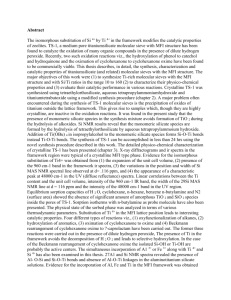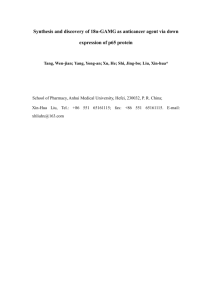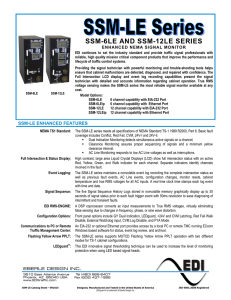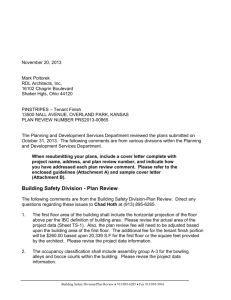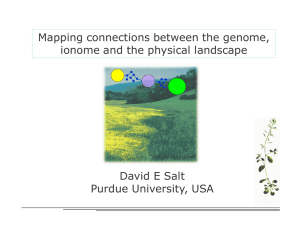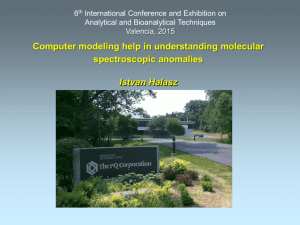vii TABLE OF CONTENTS CHAPTER
advertisement
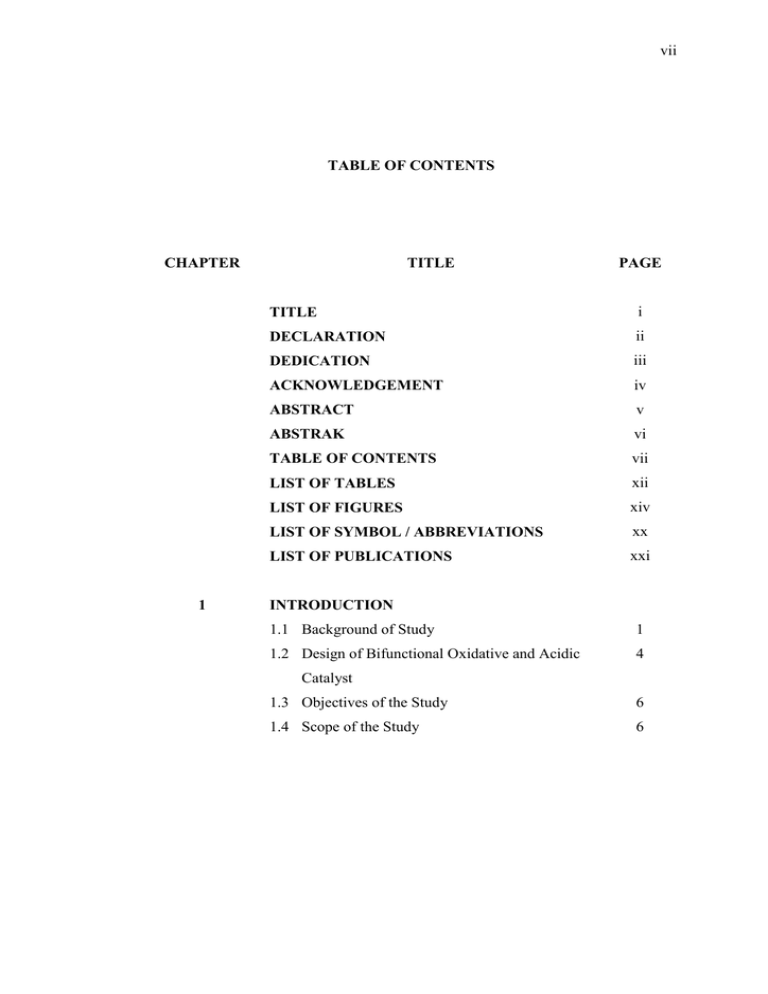
vii TABLE OF CONTENTS CHAPTER 1 TITLE PAGE TITLE i DECLARATION ii DEDICATION iii ACKNOWLEDGEMENT iv ABSTRACT v ABSTRAK vi TABLE OF CONTENTS vii LIST OF TABLES xii LIST OF FIGURES xiv LIST OF SYMBOL / ABBREVIATIONS xx LIST OF PUBLICATIONS xxi INTRODUCTION 1.1 Background of Study 1 1.2 Design of Bifunctional Oxidative and Acidic 4 Catalyst 1.3 Objectives of the Study 6 1.4 Scope of the Study 6 viii 2 LITERATURE REVIEW 2.1 Bifunctional Oxidative and Acidic Catalyst 8 2.2 Titanium Silicalite Molecular-sieves 10 2.2.1 Molecular Structure of TS-1 11 2.2.2 Synthesis of TS-1 15 2.2.3 Catalysis by TS-1 17 2.3 Metal Oxides as Solid Acid Catalysts 20 2.4 Modifications of Silica Based Molecular- 22 sieves 3 SYNTHESIS, ACTIVITY CHARACTERIZATION OF AND TITANIUM-SILICALITE MOLECULAR SIEVES 3.1 Introduction 25 3.2 Experimental 26 3.2.1 Materials Preparation 26 3.2.2 Characterization 28 3.2.3 Catalytic Test 30 3.3 Results and Discussion 30 3.3.1 X-ray Diffraction 30 3.3.2 Infrared Spectroscopy 33 3.3.3 Ultra Violet - Visible Diffuse 35 Reflectance Spectroscopy 3.3.4 Temperature Programmed Desorption 39 of Ammonia 3.3.5 Hydroxyl Groups and Acidic Sites 41 3.3.6 Epoxidation of 1-Octene 45 ix 4 SULFATED TITANIUM SILICALITE 4.1 Introduction 50 4.2 Experimental 51 4.2.1 Preparation of Sample 51 4.2.2 Characterizations 53 4.3 Results and Discussion 5 54 4.3.1 Structure Characterization 54 4.3.2 Acidity Studies 62 4.3.3 Catalytic Activity 65 TUNGSTEN OXIDE ON THE SURFACE OF TITANIUM SILICALITE 5.1 Introduction 69 5.2 Experimental 70 5.2.1 Preparation of Sample 70 5.2.2 Characterizations 71 5.3 Results and Discussion 72 5.3.1 X-ray Diffraction 72 5.3.2 Infrared Spectroscopy 75 5.3.2.1 Hydroxyl Stretching Region 75 5.3.2.2 Framework Vibration Region 78 5.3.3 UV - Visible Diffuse Reflectance 82 Spectroscopy 5.3.4 Temperature Programmed Reduction 83 5.3.5 Acidity 87 5.3.6 Catalytic Test 89 x 6 SULFATED ZIRCONIA DISPERSED ON TITANIUM SILICALITE 6.1 Introduction 95 6.2 Experimental 96 6.2.1 Preparation of Sample 96 6.2.2 Characterizations 98 6.2.3 Catalytic Activity 98 6.3 Results and Discussion 6.3.1 Structure and Acidity of SZ from 99 99 Zirconium Sulfate 6.3.1.1 X-ray Diffraction 99 6.3.1.2 Temperature Programmed 102 Reduction 6.3.1.3 UV-Visible Diffuse 105 Reflectance Spectroscopy 6.3.1.4 Infrared Spectroscopy 106 6.3.1.5 Acidity 110 6.3.2 Sulfated Zirconia Dispersed on the 116 TS-1 (SZ/TS-1) 6.3.2.1 X-ray Diffraction 116 6.3.2.2 Infrared Spectroscopy 118 6.3.2.3 UV-Visible Diffuse 120 Reflectance Spectroscopy 6.3.2.4 Temperature Programmed 121 Reduction 6.3.2.5 Acidity 6.3.3 Catalytic Activity 123 131 xi 7 NIOBIC ACID DISPERSED OVER TITANIUM SILICALITE 7.1 Introduction 136 7.2 Experimental 137 7.2.1 Preparation of Sample 137 7.2.2 Characterizations 139 140 7.3 Results and Discussion 7.3.1 X-ray Diffraction 140 7.3.2 Infrared Spectroscopy 142 7.3.3 UV-Visible Diffuse Reflectance 143 Spectroscopy 8 7.3.4 Temperature Programmed Reduction 146 7.3.5 Hydroxyl Groups 149 7.3.6 Acidity Study 151 7.3.7 Catalytic Activity 157 SUMMARY OF THE ACTIVITY OF 162 BIFUNCTIONAL OXIDATIVE AND ACIDIC CATALYSTS 9 CONCLUDING REMARKS 166 REFERENCES 169 PUBLICATIONS 191 xii LIST OF TABLES TABLE NO. 2.1 TITLE Types and numbers of catalysts used in industrial processes PAGE 20 (Tanabe and Hölderich, 1999). 2.2 The acid strength of zeolites in water (Paze et al., 1998). 21 2.3 Acid sites on various transition metal oxides determined by 22 ammonia or pyridine adsorption (Kung, 1989). 3.1 Chemical composition and method of preparation 27 3.2 Structure and crystallinity of samples by X-ray diffraction 31 technique 3.3 Infrared wavenumber of the samples 33 3.4 The number and strength of acid sites in the samples 39 3.5 Amount of Brønsted and Lewis acid sites of the samples on the 45 basis of pyridine absorption, after evacuation at 150oC 4.1 Initial titanium compositions of the samples 53 4.2 The highest peak intensity and phases of the samples 57 4.3 The percentage of tetrahedral titanium based on TS-1 and band 60 positions in the UV-Vis DR spectra 4.4 Acid strength by Hammet indicator 63 4.5 Amount of Lewis acid sites (1445 cm-1) of the samples 65 4.6 The yield of 1,2-octanediol from epoxidation of 1-octene using 68 H2O2 as oxidant after 48 h. 5.1 Amount of WO3 loading of the samples using neutral preparation 71 conditions and TS-1 as support 5.2 The amount of the Brønsted and Lewis acid sites of the samples 89 xiii 5.3 The 1-octene conversion in the epoxidation reaction with H2O2 at 90 70oC catalyzed by TS-1 and WO3/TS-1 5.4 Catalytic activity of the WO3/TS-1 in the epoxidation of 1-octene 94 with H2O2 at 70oC for 48 h 6.1 Zirconium content and preparation condition of the samples 97 6.2 Reduction temperature and hydrogen consumed of the samples 104 7.1 Chemical compositions of the samples and preparation method 138 7.2 Structure and crystallinity of samples 142 7.3 The amount of the Brønsted and Lewis acid sites and the area 155 under the peak at around 1490 cm-1 of the samples 7.4 Catalytic activity of the Nb/TS-1 in the epoxidation of 1-octene o with H2O2 at 70 C for 48 h 158 xiv LIST OF FIGURES FIGURE NO. 1.1 TITLE PAGE Oxidative and acidic catalyst for consecutive oxidation and acid 5 catalytic reactions 1.2 Methodology of research 7 2.1 Epoxidation of alkenes to epoxide and consecutive acid 10 catalyzed reactions (van der Wall et al. 1998). 2.2 The features of MFI type zeolite: (1) crystal morphology; (2) 12 pore section; (3) part of the crystal structures; (4) detail of the atomic structure (Cundy and Cox, 2003). 2.3 Location of titanium in the TS-1 structure (Henry et al. 2001). 13 2.4 Pore system in the zeolite beta. (a) Periodic Building Unit seen 14 along the plane normal, (b) Cell content in *BEA seen along b (left) and a (right) (Baerlocher et al., 2001). 2.5 Structure of MCM-41 shows distance between the pore = 3.5 nm, 14 amorphous wall structure and hexagonal pore (Gusev, 1998). 2.6 Some examples of reagent mixtures for TS-1 preparation. 16 TEOS(T): tetraethyl orthosilicate (titanate); TB(P)OT: tetrabutyl (propyl) orthotitanate; TPA+: tetrapropyl ammonium; TB(E)A+: tetrabutyl (ethyl) ammonium; TB(E)P+: tetrabutyl (ethyl) phosphonium 2.7 Types of reactions catalyzed by TS-1 (Katz, 1999). 19 3.1 Experimental setup for hydroxyl groups and acidity analysis 29 3.2 XRD pattern of the TiO2, silicalite, ZSM-5 and TS-1 samples 32 3.3 FTIR spectra of the TiO2, silicalite, ZSM-5 and TS-1 samples 34 xv 3.4 Infrared spectra of TS-1 samples in the region of 1000 – 700 cm-1 36 and the intensity ratio of peak at about 970 to 800 cm-1 3.5 UV-vis DR spectra of the TiO2, silicalite, ZSM-5 and TS-1 37 samples 3.6 The relationships between concentration of titanium in the 38 tetrahedral coordination (peak at 215 nm) and amount of titanium in the initial gel (%mol) 3.7 TPD-NH3 thermogram of the silicalite, ZSM-5 and TS-1 samples 40 3.8 Infrared spectra of the silicalite, ZSM-5 and TS-1 samples in the 42 hydroxyl groups region, after evacuation at 400oC in vacuum 3.9 Infrared spectra of the samples after evacuation at 400oC in 44 vacuum followed by pyridine adsorption at room temperature and desorption at 150oC for one hour 3.10 The interaction between tetrahedral titanium and pyridine 45 molecule 3.11 Yield of 1-octene epoxidation using H2O2 at 70oC catalyzed by 46 TS-1 with various titanium contents 3.12 Relation between tetrahedral titanium content (IR data) and 47 catalytic activity (yield of 1,2-epoxyoctane for 6 hours of reaction time) of the samples 3.13 Reactive oxygen species in the titanosilicates (Chaudari et al., 48 2001). 3.14 The effect of reaction mixture addition to the rate of formation of 49 1,2-epoxyoctane. Conditions: 5 mmol 1-octene in 5 g acetone, 7 mmol H2O2, catalyst: 0.025 g TS-1 (1%) at 70oC. [A]. 1-octene + H2O2 + TS-1, [B]. 1-octene + TS-1 + H2O2, and [C]. TS-1 + H2O2 + 1-octene 4.1 TPR profiles of the SO42-/TS-1 and SO42-Ti/TS-1 samples 55 4.2 XRD pattern of the TS-1, sulfated TS-1 and sulfated titanium TS- 56 1 4.3 Infrared spectra of the TS-1, sulfated TS-1 and sulfated titanium TS-1 58 xvi 4.4 UV-Vis DR spectra of the ZSM-5, TS-1, SO42-/TS-1 and SO42- 60 Ti/TS-1 samples 4.5 FTIR spectra of the TS-1, SO42-/TS-1 and SO42-Ti/TS-1 samples 62 after heated at 400oC for 4 h in vacuum 4.6 Infrared spectra of the samples after following treatments: 64 o heating at 400 C for 4 h in vacuum, adsorbed pyridine at room temperature, and desorption pyridine at 150oC for an hour 4.7 The yield of 1,2-epoxyoctane on the epoxidation of 1-octene 66 using TS-1, SO42-/TS-1 and SO42-Ti/TS-1 4.8 Proposed model of the local environment structure of Ti; (a) 66 bipodal, (b) tetrapodal and (c) tripodal 5.1 XRD patterns of the TS-1 and tungsten-coated TS-1 samples 73 5.2 The WO3 content vs. XRD peak intensity ratio of WO3 to TS-1 in 75 the samples 5.3 Infrared spectra in the range of hydroxyl groups observation for 76 titanium silicalite samples with different WO3 content 5.4 The WO3 content vs ratio of the IR peak area at 3726 cm-1 to 78 1880 cm-1 and 3505 cm-1 to 1880 cm-1 in the samples 5.5 The framework vibration of the TS-1 and tungsten-coated TS-1 80 samples 5.6 The WO3 content vs ratio of the IR peak area at the range 900- 81 700 cm-1 to 548 cm-1 in the samples 5.7 UV-Visible DR spectra of TS-1, WO3, and WO3/TS-1 samples 83 5.8 TPR profiles of WO3/TS-1 samples 85 5.9 Correlation between WO3 content and hydrogen consumed of the 86 samples 5.10 Infrared spectra of the samples after evacuation at 400oC in 88 vacuum followed by pyridine adsorption at room temperature and desorption at 150oC for one hour 5.11 The yield of 1,2-epoxyoctane from 1-octene epoxidation using 91 H2O2 at 70oC catalyzed by TS-1 and WO3/TS-1 5.12 The yield of 1,2-octanediol from 1-octene epoxidation of using H2O2 at 70oC catalyzed by TS-1 and WO3/TS-1 93 xvii 5.13 The yield of 1,2-octanediol at 48 h of reaction time and the ratio 94 of 1,2-octanediol to the amount of Brønsted acid sites in various catalysts 6.1 XRD pattern of the Zr(SO4)2 calcined at the various temperature 101 for 6 h 6.2 Diffraction line intensity of tetragonal and monoclinic phases, 102 and its ratio 6.3 TPR profiles of the samples zirconia free-sulfate and zirconium 103 sulfate calcined at various temperatures 6.4 UV-Vis DR spectra of the samples SZ at various calcination 106 temperature 6.5 Infrared spectra in the sulfate region of the zirconium sulfate 108 calcined at the temperature 500, 600 and 700oC for 6 h. 6.6 Infrared spectra of self-supported wafer of the zirconium sulfate 109 calcined at the temperature 500, 600 and 700oC for 6 h in the hydroxyl region 6.7 Infrared spectra in the hydroxyl region of the zirconium sulfate 110 samples after pyridine adsorption 6.8 Infrared spectra of the samples after following treatments: 113 evacuation at 400oC, pyridine adsorption at room temperature, and desorption at 150oC for 1 h 6.9 Amount of Brønsted (B; 1545 cm-1) and Lewis (L; 1444 cm-1) 114 acid sites calculated by pyridine adsorption, and ∆S=O for the sample zirconium sulfate calcined at different temperatures 6.10 Infrared spectra of the sample SZ500 after evacuation at different 115 temperature at 150, 300 and 400oC for 1 h 6.11 XRD pattern of the SZ500 and SZ/TS-1 samples 117 6.12 The graph of peak intensity of TS-1 at 2θ=23o vs loading amount 118 of zirconium on the samples 6.13 Infrared spectra of the samples in the framework region 119 6.14 UV-Visible DR spectra of the samples 121 6.15 TPR profiles of samples 122 xviii 6.16 FTIR spectra of the SZ/TS-1 samples after evacuation at 400oC 124 for 4 h in vacuum condition 6.17 FTIR spectra of the SZ/TS-1 samples in the pyridine and sulfate 125 region 6.18 FTIR spectra of the SZ/TS-1 samples after pyridine adsorption 127 o and evacuation at 150 C for 1 h. in the hydroxyl region 6.19 FTIR spectra of the SZ/TS-1 samples after pyridine adsorption 128 and evacuation at 150oC for 1 h. in the pyridine and sulfate regions 6.20 Amount of Brønsted and Lewis acid sites of the samples SZ/TS-1 129 o calculated based on the pyridine peak after evacuation at 150 C for 1 h 6.21 FTIR spectra of the sample 20SZ/TS-1. (A). after evacuation at 130 400oC for 6 h., (B). after pyridine adsorption and evacuation at 150oC for 1 h., (C). after evacuation at 300oC, and (D). after evacuation at 400oC 6.22 The yield of 1,2-epoxyoctane from reaction of 1-octene 132 epoxidation using H2O2 as oxidant in the solvent acetone at 70oC catalyzed by various contents of zirconium sulfate-promoted TS1 6.23 The yield of 1,2-octanediol from reaction of 1-octene epoxidation 134 using H2O2 as oxidant in the solvent acetone at 70oC catalyzed by various contents of zirconium sulfate-promoted TS-1 6.24 The Proposed model of TS-1 loaded with sulfated zirconia as 135 bifunctional catalyst for consecutive transformation of 1-octene to 1,2-octanediol through the formation of 1,2-epoxyoctane 7.1 XRD pattern of the NBA, NBO, TS-1 and XNb/TS-1 samples 141 7.2 FTIR spectra of the NBA, NBO, TS-1 and XNb/TS-1 samples 145 7.3 UV-Vis DR spectra of the NBA, NBO, TS-1 and XNb/TS-1 146 samples 7.4 TPR profiles of the NBA, NBO, TS-1 and XNb/TS-1 samples 148 7.5 FTIR spectra of the samples in the hydroxyls region, after 150 evacuation under vacuum at 200oC xix 7.6 FTIR spectra of the sample 3Nb/TS-1 in the hydroxyls region 152 after evacuation under vacuum at temperature 120, 200 and 400oC 7.7 FTIR spectra of the NBA, NBO, TS-1 and XNb/TS-1 samples 153 after evacuation at 200oC for 24 h. followed by pyridine adsorption at room temperature and evacuation at 150oC for one hour, in the pyridine regions 7.8 Correlation between the niobium content and the amount of acid 155 sites of the catalysts 7.9 The formation of 1,2-epoxyoctane from 1-octene epoxidation 159 o using H2O2 at 70 C catalyzed by NBA, NBO, TS-1 and XNb/TS1 7.10 The yield of 1,2-octanediol from 1-octene epoxidation of using 160 H2O2 at 70oC catalyzed by NBA, NBO, TS-1 and XNb/TS-1 7.11 Correlation between the yield of 1,2-octanediol and amount of 161 Brønsted acid sites of the catalysts 8.1 The yield of 1,2-octanediol over prepared catalysts 164 8.2 The ratio of the yield of 1,2-octanediol to the amount of Ti4+ in 165 the prepared catalysts 8.3 Correlation of the selectivity of 1,2-octanediol and the amount of Brønsted acid sites in the prepared catalysts 165 xx LIST OF SYMBOL / ABRREVIATIONS FTIR - Fourier Transform Infrared GC - gas chromatography GC-MSD - gas chromatography mass spectrometry detector h - hour NBA - niobium oxide hydrated or niobic acid NBO - niobium oxide SIL - silicalite SZ - sulfated zirconia TEOS - tetraethylorthosilicate TEOT - tetraethylorthotitanate TPAOH - tetrapropylammonium hydroxide TPD-Ammonia - Temperature Programmed Desorption of Ammonia TPR - Temperature Programmed Reduction TS-1 - titanium silicalite - 1 UV-Vis DR - Ultra Violet - Visible Diffuse Reflectance wt% - weight % XRD - X-ray Diffraction xxi LIST OF PUBLICATIONS International Journals: 1. Didik Prasetyoko, Salasiah Endud, Halimaton Hamdan, Zainab Ramli, and Bogdan Sulikowski. “Crystalline Silica of the Rice Husk Ash is Transformed into Zeolite Beta”. Waste Management. Accepted, September 16, 2005. 2. Didik Prasetyoko, Zainab Ramli, Salasiah Endud, and Hadi Nur. “TS-1 Loaded with Sulfated Zirconia as Bifunctional Oxidative and Acidic Catalysts for Transformation of 1-Octene to 1,2-Octanediol”. Journal of Molecular Catalysis A. Chemical. 241: 118-125, 2005. 3. Didik Prasetyoko, Zainab Ramli, Salasiah Endud, and Hadi Nur. “Preparation and Characterization of Bifunctional Oxidative and Acidic Catalysts Nb2O5/TS-1 for Synthesis of Diols”. Materials Chemistry and Physic. 93: 443-449, 2005. 4. Didik Prasetyoko, Salasiah Endud, Zainab Ramli and Hadi Nur. “Enhancement of Catalytic Activity of Titanosilicalite-1 – Sulfated Zirconia Combination Towards Epoxidation of 1-Octene with Aqueous Hydrogen Peroxide”. Reaction Kinetics and Catalysis Letters. 86(1): 83-89, 2005. 5. Hadi Nur, Didik Prasetyoko, Salasiah Endud, and Zainab Ramli. “Sulfation: a Simple Method to Enhance the Catalytic Activity of TS-1 in Epoxidation of 1Octene with Aqueous Hydrogen Peroxide”. Catalysis Communications. 5: 725728, 2004. 6. Didik Prasetyoko, Zainab Ramli, Salasiah Endud, and Hadi Nur. “Structural and Superacidity Study of Bifunctional Catalyst, Malaysian Journal of Chemistry. 7(1): 011-018, 2005. Sulfated-Titanium/TS-1”. xxii Conference and National Publications: 1. Didik Prasetyoko, Zainab Ramli, Salasiah Endud, and Hadi Nur. “Structural and acidity studies of sulfated zirconia prepared from zirconium sulfate”. Submitted to Majalah IPTEK - ITS, June 2005. 2. Didik Prasetyoko, Zainab Ramli, Salasiah Endud, and Hadi Nur. “Niobic Acid Dispersed on the Surface of TS-1: Acidity Study”. Seminar Nasional Kimia. 9 August 2005. Surabaya, Indonesia. 3. Zainab Ramli, Didik Prasetyoko, Salasiah Endud, and Hadi Nur. “Characterization of Bifunctional Oxidative and Acidic Catalyst, Zirconium Sulfate Loaded Titanium Silicalite”. The XXI Regional Conference on Solid State Science & Technology (RCWSST), 10-13 October 2004. Sabah, Malaysia. 4. Didik Prasetyoko, Zainab Ramli, Salasiah Endud, and Hadi Nur. “Preparation and Characterization of Bifunctional Oxidative and Acidic Catalysts Nb/TS-1”. International Conference on X-Ray Applications in Research & Industry (ICXRI), 14-15 September 2004. Pulau Pinang, Malaysia. 5. Zainab Ramli, Didik Prasetyoko, Salasiah Endud, and Hadi Nur. “Monolayer Coverage and Acidity Study of Bifunctional Oxidative Acidic Catalyst by Infrared Spectroscopy: Zirconia Sulfate Loaded Titanium Silicalite”. Simposium Kimia Analisis Malaysia (SKAM-17). 24-26 August 2004. Pahang, Malaysia. 6. Didik Prasetyoko, Zainab Ramli, Salasiah Endud, and Hadi Nur. “A New Approach to Probe the Dispersion Capacity of Tungsten Oxide on the Surface of Titanium Silicalite by Infrared Spectroscopy”. Annual Fundamental Science Seminar (AFSS), 2004. Johor Bahru, Malaysia.
